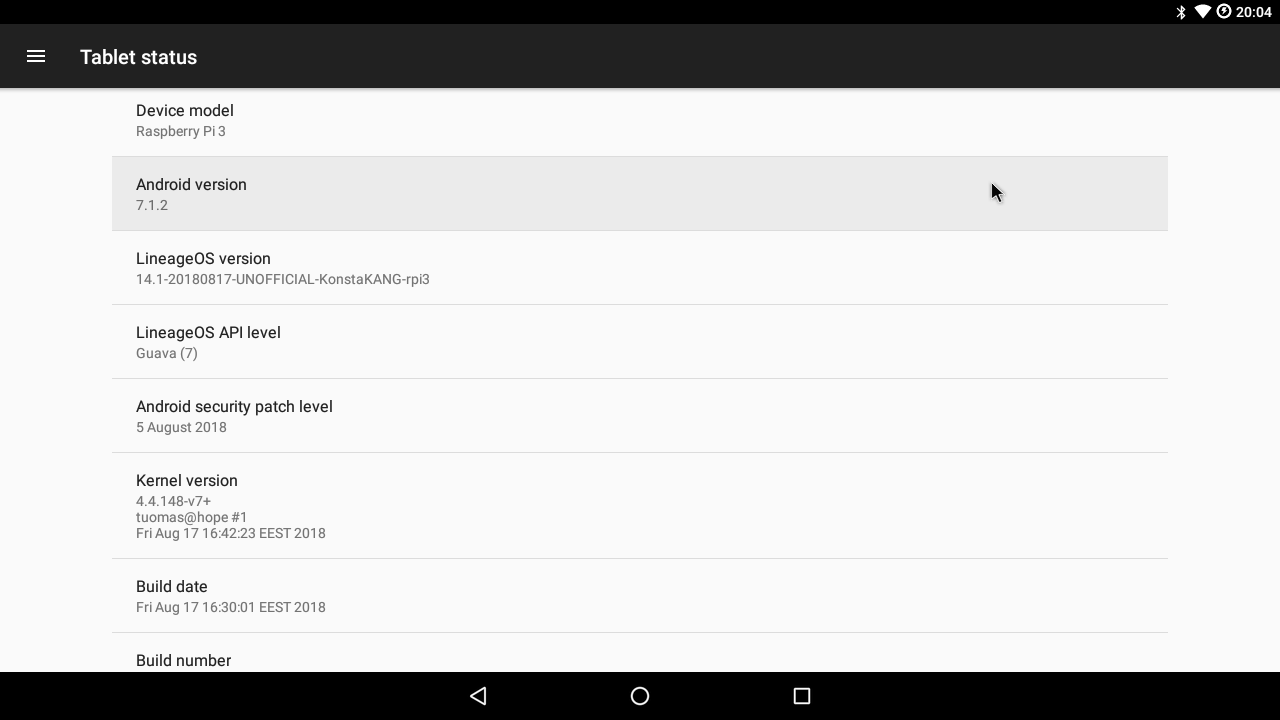Here’s my build of LineageOS 14.1 for Raspberry Pi 3 Model B. It is unofficial and unsupported by the LineageOS team. It’s for advanced users only.

Do not mirror my builds! Please post a link to this page instead.
Note! This release is discontinued from development, seriously outdated, and no longer available. Please consider updating to newer hardware to use more recent Android releases instead.
lineage-14.1-20180817-UNOFFICIAL-KonstaKANG-rpi3.zip
md5:affa35dd70b51e4b70c9acb996f7304b
Sources:
Thanks:
- peyo-hd and everyone who’s contributed to android-rpi
- LineageOS team & everyone who’s been working on CM14.1
How to install:
- Follow the official Raspberry Pi instructions for writing the image to the SD card.
FAQ:
Q: I can’t find developer options, why?
A: Settings -> About phone -> Click ‘Build number’ several times
Q: I don’t have reboot options in power menu, why?
A: Settings -> Developer options -> Advanced restart
Q: I have no root, why? What is that hashtag on my status bar?
A: You need enable root access under Settings -> Developer options -> Root access. Root management is now integrated as part of LineageOS’ Privacy Guard and you can manage per app permissions under Settings -> Developer options -> Manage root access. You’ll have a persistent notification in the status bar when you’re running an app that uses root permissions.
Q: I have official 7” LCD display and touchscreen. What should I do?
A: Execute following commands in ‘adb shell’/serial console/terminal (you can enable built-in terminal app from Settings -> Developer options -> Local terminal) and reboot your device:
su
rpi3-display.sh
Q: Settings -> Storage shows xx GB used by system. There’s unallocated space on my sdcard. What should I do?
A: This is a 4 GB image, remaining space on your sdcard will remain unallocated. Settings app shows unallocated space as used by system which in reality it is not. You can use e.g. GParted and extend /data partition (/dev/block/mmcblk0p3) to cover the unallocated space. Resizing the partition manually will break support for encrypting /data. Format /data in TWRP recovery (Wipe->Format data) after resizing to leave required space for crypto footer.
Q: Raspberry Pi doesn’t have power button, how do I power off/reboot my device?
A: Following keyboard keys work as Android buttons: F1 = Home, F2 = Back, F3 = Multi-tasking, F4 = Menu, F5 = Power, F11 = Volume down, and F12 = Volume up. You can also use one of many third party reboot applications.
Q: How to boot to TWRP recovery?
A: There’s currently no proper way to boot between Android and TWRP, but this can achieved by renaming the ramdisk you want to boot. Execute following commands in ‘adb shell’/serial console/terminal (you can enable built-in terminal app from Settings -> Developer options -> Local terminal) and reboot your device:
su
rpi3-recovery.sh
If mouse cursor doesn’t appear, try replugging your mouse.
Q: How to boot out of TWRP recovery?
A: Flash my recovery2boot zip in TWRP.
Q: How to install Google apps?
- Download open_gapps-arm-7.1-pico-xxxxxxxx.zip and save it to your device’s internal storage or use an external USB drive
- Boot to TWRP recovery (see FAQ)
- Install open_gapps-arm-7.1-pico-xxxxxxxx.zip from your selected storage
- Wipe->Factory reset!
- Boot out of recovery (see FAQ)
Merged commits not mentioned in the changelog.
17.8. changelog:
- include TWRP 3.2.3-0 custom recovery (see FAQ how to boot)
- fix Gallery app crashing (and likely various third party apps as well)
- add support for encrypting the device
- merge AOSP kernel/common android-4.4-n branch to have proper Android Nougat kernel
- update to Linux 4.4.148 kernel and patch known vulnerabilities (CVE-xxxx-xxxx, and more)
- Android security patch level: 5 August 2018 (merged)
15.6. changelog:
- add support for USB webcams (UVC) with third party USB webcam apps
- default to noop I/O scheduler
- update to Linux 4.4.137 kernel and patch known vulnerabilities (CVE-xxxx-xxxx, and more)
- Android security patch level: 5 June 2018 (merged)
15.4. changelog:
- update audio HAL (fix USB microphone, etc)
- add support for external USB GPS dongles (1546:01a7 U-Blox AG, etc - GPS dongle must be plugged-in while booting the device)
- update to Linux 4.4.127 kernel and patch known vulnerabilities (CVE-xxxx-xxxx, and more)
- Android security patch level: 5 April 2018 (merged)
18.1. 2018 changelog:
- add support for I2C devices
- enable Android low-RAM configuration
- add lights HAL to control display brightness from Android on offical RPI display (version 1.1)
- update to Linux 4.4.112 kernel and patch known vulnerabilities (CVE-xxxx-xxxx, and more)
- Android security patch level: 5 January 2018 (merged)
17.11. changelog:
- fix wifi reconnect on boot (thanks to Google)
- update to Linux 4.4.97 kernel and patch known vulnerabilities (CVE-xxxx-xxxx, and more)
- patch recently disclosed BlueBorne and KRACK vulnerabilities (merged)
- Android security patch level: 5 October 2017 (merged)
10.8. changelog:
- update to Linux 4.4.80 kernel
- merge AOSP kernel/common android-4.4 branch to have proper Android kernel
- enable sdcardfs
- add BFQ i/o scheduler and enable it by default
- Jelly browser (merged)
- Android security patch level: 5 August 2017 (merged)
16.4. changelog:
- add support for wifi tethering
- add support for Widevine DRM
- improve Play Store compatibility
- Android 7.1.2 (merged)
- Android security patch level: 5 April 2017 (merged)
11.4. changelog:
- initial relase
Previous builds: